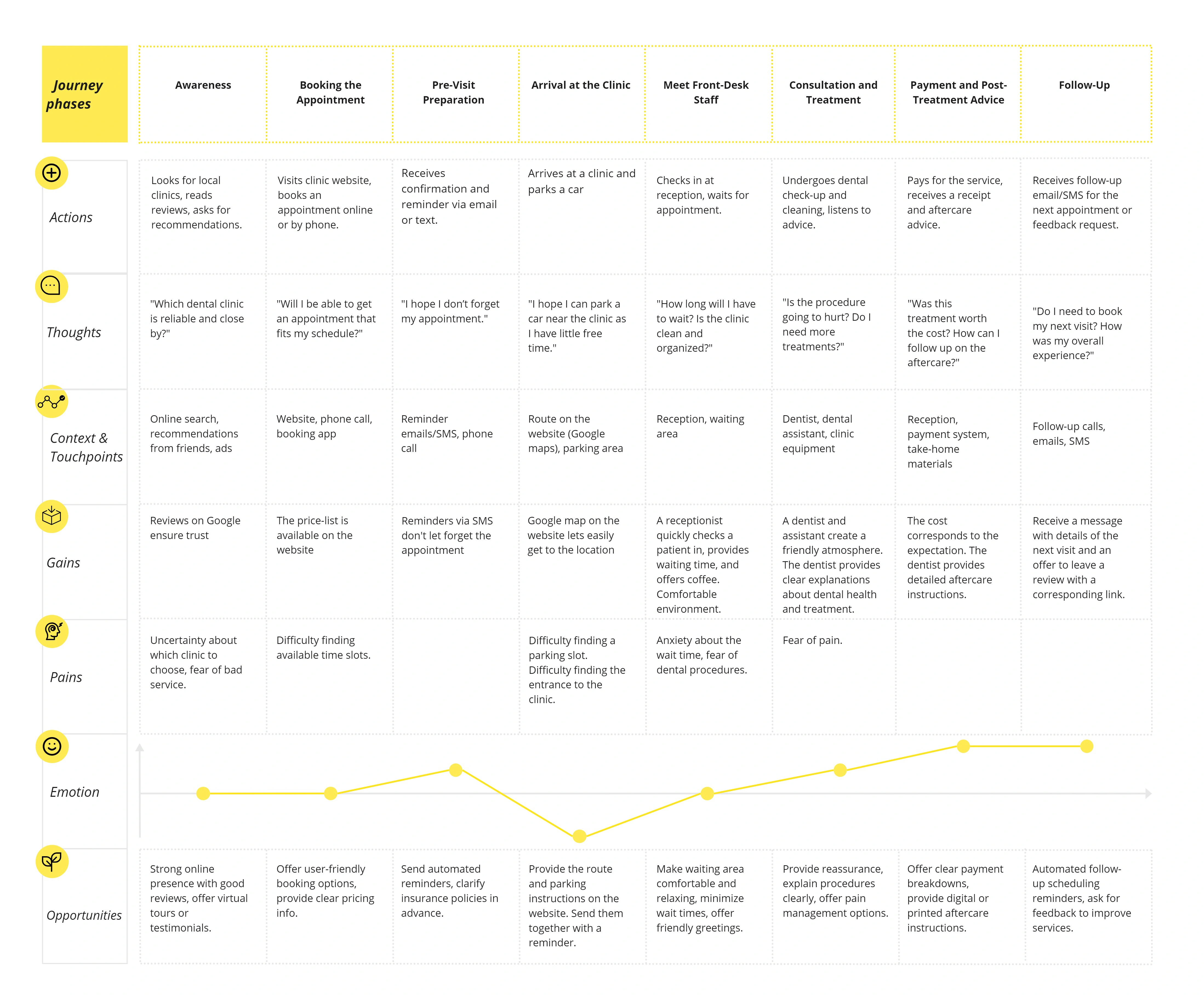
When you browse reviews of dental clinics, you’ll notice a recurring theme in negative feedback: long wait times, scheduling issues, poor communication, and billing confusion. Surprisingly, concerns about treatment outcomes are far less frequent.
This pattern highlights an important truth: patients value an overall pleasant experience, not just clinical excellence. To attract and retain patients, dental clinics must focus on more than just the quality of care — they need to offer a seamless, patient-centric service.
In the first part of the article, we’ll explore how service design can enhance patient satisfaction, streamline operations, and foster lasting relationships with patients. We’ll also share actionable tips to elevate the patient experience.
In the second part, we will highlight how service design can create meaningful benefits for both the team and the clinic.
What is Service Design?
Service design refers to the planning and organisation of people, processes, and software and material components involved in delivering a service. The goal of service design is to create a smooth, coherent, and positive experience for both patients and staff, aligning operations with patient desires.
In a dental clinic, service design focuses on ensuring that every touchpoint in the patient’s journey — from awareness to follow-up — meets the needs and expectations of the patient. The key is to identify pain points in the service delivery and find innovative solutions to eliminate them.
Let’s have a look on the journey map of a patient created for a dental clinic:
Key components of the journey:
- Pre-Visit Experience
- In-Clinic Experience
- Post-Visit Follow-Up
Let’s break down each of these components.
Pre-Visit Experience: Making the First Impression Count
The patient’s experience starts long before they set foot in your clinic. From the moment a prospective patient searches for dental services online or calls your office, they begin forming opinions about your clinic. The key is to create a frictionless and welcoming pre-visit experience.
Enhancements:
Optimised Website:
Ensure your clinic’s website is mobile-friendly, easy to navigate, and includes essential information like services, pricing, and dentist profiles. A blog or FAQ section addressing common concerns like dental anxiety or insurance coverage can build trust.
Online Booking:
Offer a simple, user-friendly online booking system that allows patients to view available appointment slots, choose their preferred dentist, and book without hassle. This system should send automatic appointment reminders via email or SMS to minimise no-shows. Strike a balance between lack of communication and overcommunication.
Clear communication:
Whether patients contact your clinic by phone, email, or social media, responses should be prompt, friendly, and informative. Offering real-time chat support on your website can also improve accessibility.
Results:
By streamlining the pre-visit process, patients will feel more confident and relaxed before their appointment, reducing anxiety and uncertainty.
In-Clinic Experience: Creating a Comfortable and Efficient Visit
The in-clinic experience is where patients will form lasting impressions of your service. Waiting times, clinic environment, and staff interactions all play crucial roles in how patients perceive your clinic.
Enhancements:
Pleasant Waiting Area:
Create a warm and inviting waiting room with comfortable seating, calming décor, and entertainment options like magazines or screens with health-related content. Offering free Wi-Fi and a welcoming atmosphere can help patients feel more at ease.
Minimise Wait Times:
Long wait times are a significant source of frustration. Implement a scheduling system that ensures efficient patient flow. Notify patients in advance if there will be any delays, and keep them informed during their wait.
Patient Comfort During Treatment:
Dental anxiety is a common issue. Dentists and hygienists should offer clear explanations of procedures before they begin, ensuring patients understand what to expect. Offering sedation options or simple comforts like music or noise-cancelling headphones can reduce stress.
Technology Integration:
Use digital tools like electronic health records (EHR) to streamline patient check-in and record management. This reduces paperwork and wait times, improving both patient experience and staff efficiency.
Results:
An efficient, comfortable, and empathetic in-clinic experience can turn a potentially stressful visit into a positive one. Patients who feel cared for are more likely to return and recommend your clinic to others.
Post-Visit Follow-Up: Building Long-Term Relationships
The patient journey doesn’t end when they leave the clinic. Follow-up communications are essential to maintaining patient relationships, ensuring compliance with treatment plans, and encouraging return visits.
Enhancements:
Automated Follow-Up Systems:
Send follow-up emails or SMS reminders for the next appointment or preventive care visits. For example, after a dental cleaning, you can send a reminder six months later, making it easy for patients to schedule their next check-up.
Personalised Aftercare Instructions:
Provide patients with easy-to-understand digital or printed instructions on how to care for their teeth after treatments. Offering a follow-up call or email to address any post-treatment concerns demonstrates commitment to their well-being.
Request Feedback:
Send a short, simple survey to collect feedback on their experience. This not only shows that you value their opinion but also helps you identify areas for improvement.
Results:
Post-visit engagement builds patient loyalty and reinforces your clinic’s commitment to preventive care. Positive follow-up experiences encourage patients to book future appointments and refer others to your clinic.
Internal Processes and Communication: Empowering Your Team
While the patient experience is critical, the backbone of excellent service design lies in effective internal processes and communication. Your team’s efficiency, coordination, and morale directly impact the quality of care provided.
Enhancements:
Staff Training:
Regularly train staff on patient communication, service protocols, and the latest dental technologies. A well-informed and empathetic team enhances the patient experience.
Cross-Functional Collaboration:
Ensure seamless communication between administrative staff, dental assistants, hygienists, and dentists. Use integrated software systems that allow for smooth patient management and prevent scheduling errors.
Feedback Loop:
Create a feedback loop where staff can share their experiences and insights into how processes can be improved. A culture of continuous improvement ensures that your clinic evolves with patient needs.
Results:
By empowering your team with the right tools and training, you can reduce inefficiencies, improve patient care, and foster a positive work environment that benefits both staff and patients.
Conclusion: Designing for Success
Enhancing service design in a dental clinic is about creating a patient-centric approach that anticipates patient needs, removes barriers, and delivers a seamless experience from start to finish. By focusing on improving the pre-visit, in-clinic, and post-visit processes, while ensuring internal communication and efficiency, dental clinics can foster patient loyalty, improve care outcomes, and position themselves as leaders in the healthcare sector.
Investing in service design isn’t just about operational efficiency — it’s about building trust and relationships that will benefit both your clinic and your patients in the long term.


